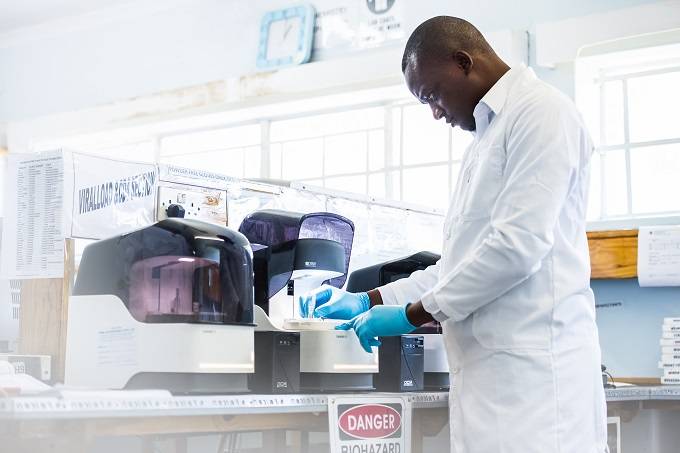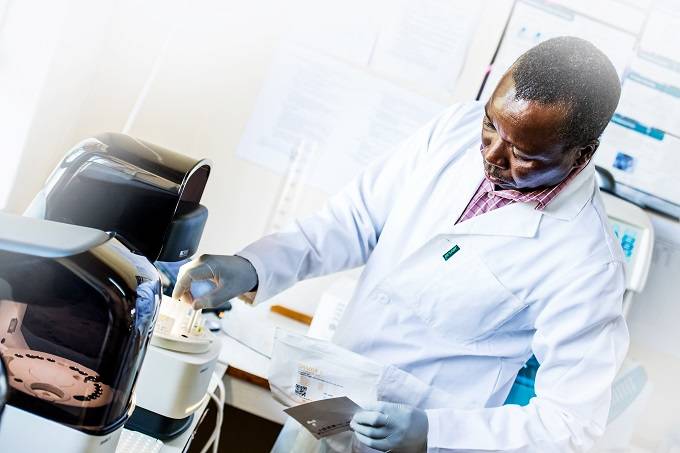
The Sunday News

Tinomuda Chakanyuka
SINCE 2016 Martha has been taking HIV viral load tests religiously.
She has been living with the virus for 12 years now, and knows pretty well how important it is for her to regularly measure the level of HIV virus in her blood stream.
Martha is one of the estimated 1,2 million Zimbabweans living with HIV and are on treatment. An approximate 300 000 others are on the waiting list. Zimbabwe targets to have 90 percent of its citizens on HIV treatment to be virally suppressed by 2030, as part of efforts to end Aids as a public health threat. But with only 16 conventional diagnostic platforms in 13 laboratories offering Viral Load testing using a centralised approach, meeting this target is a long shot.

Martha takes a viral load test once every six months at Chironde Clinic in Shurugwi, a mining town in Zimbabwe’s Midlands Province.
Chironde Clinic is a typical Zimbabwe rural clinic. It is not equipped with much equipment, not to mention highly complex viral load testing machines that require infrastructure, trained personnel and air-conditioning.
As a result, Martha’s blood samples are transported to Shurugwi District Hospital where they are further conveyed to Gweru Provincial Hospital.
At Gweru Provincial Hospital the samples join a plethora of other samples from across the eight districts in the Midlands Province. The samples are waiting in a queue to be transported to Mpilo Central Hospital in Bulawayo for testing.
The turnaround period for Martha’s results is usually between three and six weeks but often much longer.
Frustrating isn’t it?
Just what is viral load testing and why is it so important for people living with HIV.
Guided by World Health Organisation guidelines, the Ministry of Health and Child Care has implemented a programme which measures the effectiveness of treatment by measuring twice a year the level of HIV virus in an infected person.
With effective treatment, the HIV virus can be completely suppressed with the infected person living a perfectly normal life because the virus does not multiply and its level in the blood stream is undetectable or very low. When HIV virus is well controlled, the infection does not pass on to others.
Biomedical researcher Dr Helen Lee from University of Cambridge posits, “The HIV virus can occasionally change or mutate to become resistant to the drug being used. In which case, repeat testing must be carried out and if the virus is detected above a certain level, timely switching to another effective drug becomes critical to the health of the individual.”

Viral load testing allows for treatment failure to be closely monitored by measuring in the blood stream for any signs of HIV virus growth.
With a turnaround period of three to six weeks or longer for people like Martha to get their results, it becomes extremely difficult for her to be timeously switched to another effective drug, should the virus in her mutate.
Her health and that of many others in her circumstance are at risk. In worst cases, critically ill patients die due to delayed intervention.
Should anyone die of Aids in the 21st century? No! That Zimbabwe should decentralise viral load testing service is a no-brainer.
But conventional Viral Load testing machines are expensive, complicated and require air conditioning as well as specialised personnel. These conditions are not readily available at the majority of health centres in the country.
These large machines also come with expensive waste disposal requirements because cyanide is produced as a by-product of the testing chemistry.
Zimbabwe, currently hamstrung by a number of economic challenges may not be in a position to roll out this kind of technology countrywide.
In fact, the fuel shortage and electricity blackouts make it difficult if not impossible for samples to be transported to centralised testing labs which are in any case having problems with lack of air conditioning or electricity supply to run these large and complicated machines.
So, what are the available options? — Point of Care Technology which provides a High-Tech yet simple HIV viral load test performed at the clinic attended by the patient with results available within 90 minutes. Zimbabwe is one of the first countries to adopt a new Point of Care (POC) technology called SAMBA which was developed by scientists at the University of Cambridge in the UK.
The technology has been successfully implemented in the country for two years at 27 sites. Michael Chitemwe, a Medical Microscopist at Hatcliffe Polyclinic in Harare, says “POC HIV testing has enhanced my work significantly in the sense that results are released in less than three hours after sample collection.
“This maximises my daily throughput and at least 20 clients will get a valid result within the same day”.
He goes on to describe the SAMBA Point-of-Care technology as, “The most suitable diagnostic platform for Primary Health Care Facilities as compared to centralised testing.”
Hatcliffe Polyclinic is one of the 27 sites where the technology has been successfully implemented.
Head of HIV and Tuberculosis in the Ministry of Health and Child Care, Dr Owen Mugurungi reckons the 27 sites are not enough.
“As a country, due to limited financial resources and constrains, we have not as yet invested enough in Point-of-Care HIV testing,” he said.
Dr Mugurungi added, “Yet Point-of-Care will be a game changer. It eliminates the need for expensive sample transportation system.
“Turnaround time is reduced from several weeks to same day results and that allows clinicians to promptly make decisions without having to ask patients to come back when the results become available.”
Now the Cambridge scientists have made further improvement to the SAMBA II Point-of-Care technology by eliminating the need to collect blood from the veins of patients, which not only requires a trained nurse but also the removal of white and red blood cells by centrifuging the sample. Many rural clinics are not equipped with centrifuges which are expensive and require maintenance and calibration.
Instead, a drop of blood can be simply collected by a finger prick in adults or a heel prick in babies. The sample is placed in the portable SAMBA machine the size of a domestic coffee maker and in less than 90 minutes, the results are out.
Principal laboratory scientist in the Ministry of Health and Child Care Sandra Chipuka recently shared her experience of the new technology at the just ended International Conference on Aids and STIs in Africa (ICASA) in Kigali. Over 5 000 scientists, clinicians and public health officials attended the conference.
The SAMBA scientific session was co-chaired by Dr Gary Brook from Central Middlesex Hospital London and Mr Douglas Mangwanya, Head of Laboratory Services of Ministry of Health and Child Care. Both called the new SAMBA whole blood test “a real game changer” in the management of HIV therapy monitoring.
“Using only a drop of whole blood sample, the results in our evaluation showed a high level of agreement with the gold standard tests performed in centralised laboratories,” said Chipuka.
She added, “Unlike other viral load assays, venepuncture, phlebotomy and centrifugation are not required and this drastically simplifies the testing procedure.”
For people like Martha, this new and inventive technology is what they need to easily manage their condition and live healthy normal lives.
According to the Ministry of Health and Child Care, Zimbabwe has 1 848 health centres. If each of these could be equipped with Point-of-Care HIV testing machines, this will surely consolidate the country’s efforts to end Aids as a public health threat by the year 2030.



